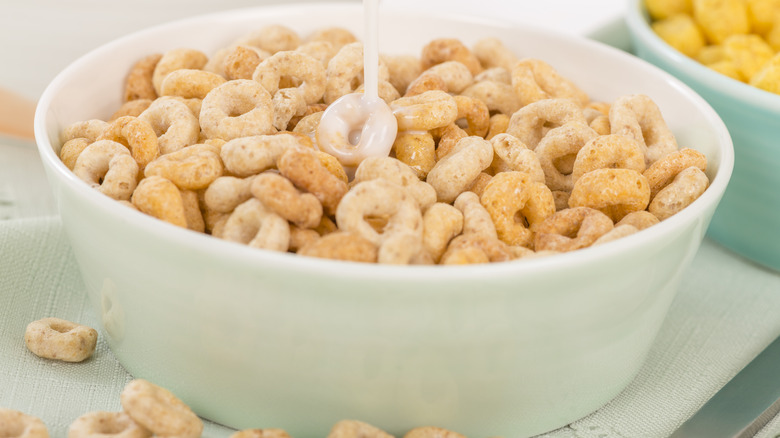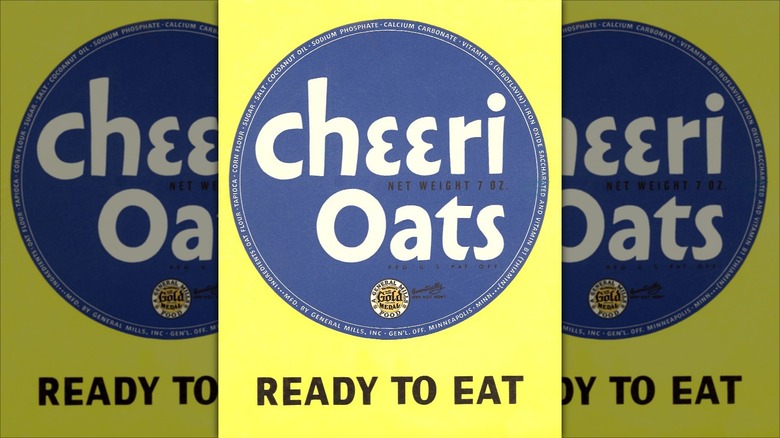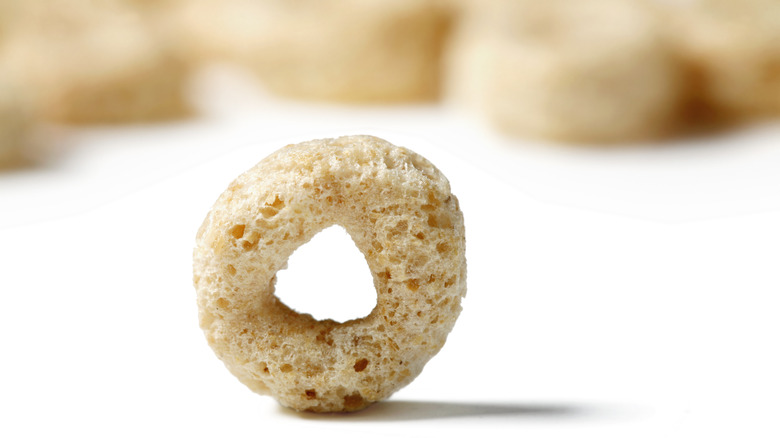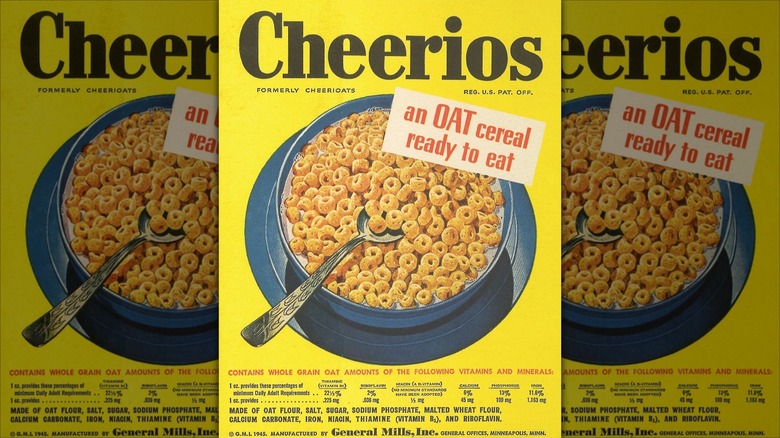You Wouldn't Recognize The First Cheerios Box And Label
If there was an official Museum of Cereal (as far as we can tell, there isn't), one of the main exhibits would be dedicated to Cheerios — truth be told, the cereal literally changed the shape of breakfast as we know it. In this corner, you'd see a box weighing in at a skimpy 7 ounces (as opposed to today's standard 8.9 ounces), but it might not look anything like what you'd expect to see. Yes, it's still yellow, although a rather subdued shade, but the label doesn't feature an image of the product. Instead, it sports a simple blue circle labeled with the word "Cheerioats."
Cheeri-what? Yes, this was the cereal's name for the first four years. As a General Mills brand representative told Mashed, the name was changed due to legal complications. So in 1945, it adopted its present-day moniker. Displayed in small lettering under the name on the earliest Cheerios boxes, however, are the words "formerly Cheerioats" to reassure anyone confused by the rechristening. Visually, these boxes are far more akin to the ones we're now familiar with since not only has the yellow hue brightened up to a considerable extent, but the design also includes the image of a cereal bowl.
In 2021, General Mills brought back the Cheerioats name for a limited-release 80th anniversary edition of the cereal. It did not, however, revive the original packaging — in all but name (as well as the addition of an anniversary logo), those boxes were nearly identical to the regular packaging.
Cheerios was the first oat cereal that didn't need cooking
One more notable thing about the Cheerioats box is that right below the blue circle, which contained the name and ingredients list (the latter circling the outside), are three more words: Ready to eat. What is the significance of this, and why do these words stand alone? As per the General Mills rep, "Cheerioats debuted in 1941 as one of the first oat-based ready-to-eat cereals." Sure, people had been eating oatmeal for years — possibly 30,000 of them according to archaeological evidence — but that stuff takes time to prepare and instant oatmeal wouldn't be a thing until the 1960s. Cheerioats allowed people to eat oats every day in a much more convenient fashion.
Before Cheerioats debuted, General Mills only offered two ready-to-eat cereals: the obviously wheat-based Wheaties as well as the corn-based Kix. Corn flakes, puffed rice, and granola were also all being marketed to consumers who wanted a quick breakfast, but up to that point, oat cereals were primarily a cook-it-yourself dish. At the time, the concept of overnight oats was about as welcome as the idea of smearing avocados on toast. So when Cheerioats hit the shelf, this may have been the first time this ancient staple was made widely available for cold consumption. Who knew it would be such a hit? Anyone investing in the product must have made a mint, though, since these days it's America's top-selling cereal.
How Cheerios got their shape
The story of how Cheerios came to be would not be complete without a discussion of one key invention: the puffing gun. This machine was created by a botanist named Alexander Anderson who came up with a way to "explode" seeds and grains so as to split them open and puff them up back in 1901. Two years later he demonstrated his new invention at the St. Louis World's Fair, selling some 25,000 packages of freshly-puffed rice cereal. By the next decade, Quaker Oats would be marketing puffed rice and wheat cereals of its own.
Cheerios, however, isn't just puffed but ring-shaped, and this shape wasn't chosen by accident. According to the brand representative, "General Mills' cereal experts in the late 1930s in Minneapolis tested over 500 formulas and 10 shapes and sizes before arriving at the now iconic O." The company also credits an engineer named Thomas James with coming up with a version of the puffing gun that could produce rings.
Interestingly enough, this wasn't the first ring-shaped cereal, as remains of some oddly Cheerio-like food items were unearthed at a Bronze Age site in Germany. Still, the cereal must have been hard to produce 3,000 years before the invention of the puffing gun, so it didn't catch on at the time. Now, however, ring-shaped cereals abound ranging from Froot Loops to Apple Jacks to Booty O's, the last-named being the official cereal of WWE Superstars The New Day.
Cheerios has always been always health-focused
While many cereals rely on clever advertising gimmicks or cartoon mascots, Cheerios has always marketed itself as a healthy breakfast option. Sure, if you (or your great-grandpa) saved up enough box tops back in the 1940s, you'd earn a patriotic prize, while at the turn of the millennium, you might find a shiny new penny inside bearing the "2000" date. Cheerios has also employed various celebrity pitchpersons throughout the years, such as Rocky and Bullwinkle in the '60s and Hulk Hogan in the '80s. Still, right from the earliest Cheerioats box, the brand likes to lead with the nutritional benefits of an oat-based breakfast.
In the words of a General Mills representative, "Since its beginning, Cheerios has always been about its simple, ingredient-first, heart-healthy whole grain oats," adding that the cereal "was a big deal for consumers who were looking for options that offered a balance between nutrition and taste." In fact, the ingredients shown on the Cheerioats box double as a nutrients list that includes calcium carbonate, riboflavin, iron, and Vitamin B1 along with the oat and corn flour, sugar, and salt that give the cereal its signature flavor. (Interestingly enough, it also contained "cocoanut oil" decades before the stuff became trendy.) While the boxes have long since shifted the nutritional data and ingredient information to the back, today's cereal proudly sports a label boasting that it can help lower cholesterol as well as a heart-shaped cereal bowl hinting at potential cardiovascular benefits.



